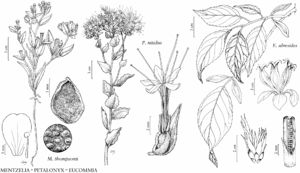Difference between revisions of "Eucommiaceae"
FNA>Volume Importer |
FNA>Volume Importer |
||
| Line 20: | Line 20: | ||
--><p>Placement of <i>Eucommia</i> has been controversial, with various authors allying it with Cornales, Euphorbiaceae, Hamamelidaceae, Trochodendraceae, and Ulmaceae (reviewed in M. A. Vincent 2002). Most recent DNA analyses support recognizing Eucommiaceae as a distinct family in Garryales (K. Bremer et al. 2001; D. E. Soltis et al. 2000). Fossil remains of <i>Eucommia</i> have been found in North America, Europe, and Asia, evidence that the genus was widespread in the Cenozoic and that its present-day distribution is relictual (V. B. Call and D. L. Dilcher 1997).</p> | --><p>Placement of <i>Eucommia</i> has been controversial, with various authors allying it with Cornales, Euphorbiaceae, Hamamelidaceae, Trochodendraceae, and Ulmaceae (reviewed in M. A. Vincent 2002). Most recent DNA analyses support recognizing Eucommiaceae as a distinct family in Garryales (K. Bremer et al. 2001; D. E. Soltis et al. 2000). Fossil remains of <i>Eucommia</i> have been found in North America, Europe, and Asia, evidence that the genus was widespread in the Cenozoic and that its present-day distribution is relictual (V. B. Call and D. L. Dilcher 1997).</p> | ||
|tables= | |tables= | ||
| − | |references= | + | |references= |
| − | |||
| − | |||
| − | |||
| − | |||
| − | |||
| − | |||
| − | |||
| − | |||
| − | |||
}}<!-- | }}<!-- | ||
| Line 43: | Line 34: | ||
|basionyms= | |basionyms= | ||
|family=Eucommiaceae | |family=Eucommiaceae | ||
| + | |illustrator=Yevonn Wilson-Ramsey | ||
| + | |illustration copyright=Flora of North America Association | ||
|distribution=Asia (c;w China);introduced and cultivated widely. | |distribution=Asia (c;w China);introduced and cultivated widely. | ||
|introduced=true | |introduced=true | ||
| − | |reference= | + | |reference=None |
|publication title= | |publication title= | ||
|publication year= | |publication year= | ||
|special status= | |special status= | ||
| − | |source xml=https://jpend@bitbucket.org/aafc-mbb/fna-data-curation.git/src/ | + | |source xml=https://jpend@bitbucket.org/aafc-mbb/fna-data-curation.git/src/eaa6e58056e40c9ef614d8f47aea294977a1a5e9/coarse_grained_fna_xml/V12/V12_198.xml |
}}<!-- | }}<!-- | ||
-->[[Category:Treatment]] | -->[[Category:Treatment]] | ||
Revision as of 19:56, 16 December 2019
Trees, deciduous, dioecious; latex present. Leaves alternate, simple; stipules absent; petiole present; blade margins serrate; venation pinnate. Inflorescences unisexual, axillary, fascicles, (staminate) or flowers solitary (pistillate. Flowers unisexual; hypanthium absent; sepals 0; petals 0; nectary absent; stamens 5–12, distinct; anthers dehiscing by longitudinal slits; pistil 1, 2-carpellate; ovary superior, 1-locular; placentation apical; ovules 2 per locule, anatropous; style 0; stigmas 2. Fruits samaras. Seeds 1 per fruit.
Distribution
Asia (c, w China), introduced and cultivated widely.
Discussion
Genus 1, species 1.
Placement of Eucommia has been controversial, with various authors allying it with Cornales, Euphorbiaceae, Hamamelidaceae, Trochodendraceae, and Ulmaceae (reviewed in M. A. Vincent 2002). Most recent DNA analyses support recognizing Eucommiaceae as a distinct family in Garryales (K. Bremer et al. 2001; D. E. Soltis et al. 2000). Fossil remains of Eucommia have been found in North America, Europe, and Asia, evidence that the genus was widespread in the Cenozoic and that its present-day distribution is relictual (V. B. Call and D. L. Dilcher 1997).
Selected References
None.
